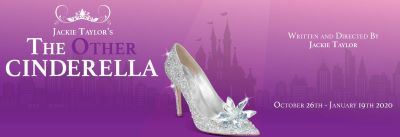
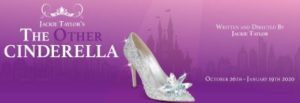 [rating=5]Wow! It’s rare to run out of superlatives to describe a performance, but “The Other Cinderella” is the height of perfection. Genius writer/director Jackie Taylor uses the backdrop of modern-day Chicago to re-set the original French version of this fairytale classic. In so doing, she creates a beautiful musical comedy that is not only of African-American interest but is sure to delight all audiences.
[rating=5]Wow! It’s rare to run out of superlatives to describe a performance, but “The Other Cinderella” is the height of perfection. Genius writer/director Jackie Taylor uses the backdrop of modern-day Chicago to re-set the original French version of this fairytale classic. In so doing, she creates a beautiful musical comedy that is not only of African-American interest but is sure to delight all audiences.
We all know the basic story. This makes its inventive retelling so much fun, with its unexpected surprises throughout.
The first is that the fairytale takes place in the Land of Other, or Other, or Otherland, a lofty place of the imagination, ruled by a black king (Dwight Neal) and his queen (Chantee Joy). Otherland’s counterpart is “the ‘hood” (short for “the neighborhood”) which mimics the reality of Chicago’s streets. Needless to say, the more obvious meaning of the word “other” in the context of this play is that it has to do with skin color: The Cinderella in this production is black, not white. In addition, she comes from the proverbial “other side of the tracks”, namely, from the projects.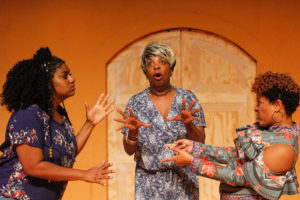
The musical begins with a clever subplot. Four men from the ‘hood—located around 70th and Constance, on Chicago’s South Side—are tight (friends), when one of them gets a job and becomes the king’s new page (a stellar performance by Stewart Romeo). Because of his new duties, the page has to leave his buddies Groundhog (Vincent Jordan), Peanut Butter (Michael Adkins), and Pee Wee (Blake Reasoner) to reside at the royal palace. The insertion of this unique and funny character into the story becomes a wonderful way to point up the clash of cultures between the black middle-class and lower-class and between what is considered hip and what is not. It also allows the play to become a spoof of the white upper-crust (at the White Castle) and serves as a device to counterpose various genres of music: ranging from jazz, soul, rhythm and blues, funk, hip-hop, traditional musical theatre songs—plus some mini-rap, dance numbers, and more—often rolled into one strong groove.
Another cultural clash is that of modern versus “old school.” The ‘hood has a modern vibe. The page has a cell phone and uses Facebook, texting, and Messenger. The king uses telegrams and snail mail and especially believes in old-fashioned traditions, such as wanting his son the prince (Blake Hawthorne) to get married. There are hints that the prince might be gay (because he hasn’t yet found a woman and he travels with male friends). But marriage and the bearing of an heir is important to the perpetuation of the lineage. Therefore, the king decides to hold a lavish ball so that the prince can meet all the fair maidens of the realm and choose from among them to marry. However, in this version of the tale, the queen takes the prince aside and adds that she won’t make him do anything he doesn’t want to do. Note that she is not necessarily deferring to her husband’s wishes.
 Now that the table has been set, it’s on to the main character. Cinderella (Jayla Williams Craig—with a gorgeous voice) is an unpaid domestic who lives with her nasty but golden-throated stepmother/stepmamma (Rhonda Preston) and her self-important and spoiled stepsisters (Justis Drakes and Jasmine Bonner). Whereas the stepsisters wear the latest clothes and jewelry and shop at the chicest stores, Cinderella wears an old dress and headscarf and sits in a corner of the room, as her
Now that the table has been set, it’s on to the main character. Cinderella (Jayla Williams Craig—with a gorgeous voice) is an unpaid domestic who lives with her nasty but golden-throated stepmother/stepmamma (Rhonda Preston) and her self-important and spoiled stepsisters (Justis Drakes and Jasmine Bonner). Whereas the stepsisters wear the latest clothes and jewelry and shop at the chicest stores, Cinderella wears an old dress and headscarf and sits in a corner of the room, as her
company is not wanted. Although she works hard at her household chores, her stepmother (who is a postal worker by day), mercilessly picks fault with her. As the three of them order her around, Cinderella grows deeply resentful. She is angry about her lot in life and scornful of how she is being treated. Unlike her mousy white counterpart, black Cinderella can be mouthy on occasion: sassy and backtalking. Why must she play third fiddle to everyone else in her family?
Of course, there is the usual story about Cinderella being ordered to stay at home and not attend the ball. But in this version, she has a Jamaican fairy godmother/godmamma who provides her with a lovely dress and shoes—and the young girl’s hair is already braided! The godmamma explains the importance of believing in yourself, being true to your spirit, and having the spirit guide you.
In addition to the subplot about the king’s new page, there is a minor storyline about a secret love interest between two servants at the royal palace (played by Micah Materre and Lemond Hayes). This is reminiscent of the “King and I” and follows up on the show’s theme that skin color shouldn’t make a difference in a romantic relationship—or any relationship, for that matter—whether among African-Americans of different skin tones or between blacks and whites.
This is put to the test when Dorothy from Kansas (Colleen Perry) is inserted into the play. She is a white girl who claims to be black and proves it by liking turnip, mustard and collard greens (with cornbread) and by singing the blues. She very much wants to fit into Otherland; so instead of wearing the checkered dress from the “Wizard of Oz”, she wears a sleek ballgown with rhinestone trim to match the well-healed African-American set (where “dressing to the nines” is part and parcel of Chicago black culture). Dorothy thus confirms that being black is something in your soul: It has nothing to do with your complexion but with how much you can “get down.”
At the end of the performance, cultural barriers break down and cultural differences become accepted. This is evinced by the three friends commenting that the fourth didn’t leave “the ‘hood”; rather, that the page brought the ‘hood to the 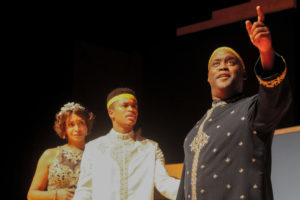 royal palace. This serves as an excellent metaphor for the appropriation of black music styles into mainstream American entertainment.
royal palace. This serves as an excellent metaphor for the appropriation of black music styles into mainstream American entertainment.
The singers’ amazing voices are complemented by the stage musicians. Rather than being located in a pit, the ensemble is on a platform high above the stage and consists of Robert Reddrick (musical director/drums), Adam Sherrod (keyboards), Mark Miller (bass), and Gary Baker (guitar).
Special mention needs to be given to Denise Karczewski for her magical effects in lighting design. Sound designer David Samba has done quite a job pulling together the mix of vocal and instrumental music. Minimal set design by Evan Frank and prop design by Mealah Heidenreich work well with the rotating set.
More kudos to Jackie Taylor for dazzling costume design. In addition to reviving her original script, she is also the founder of the Black Ensemble Theater and its chief fundraiser, not to mention a singing and acting talent in her own right. It was good to see her take the stage after the show to thank the audience.
So…. do not miss this feel-good holiday favorite! This popular tale with a twist is funny and uplifting and dashes our expectations in the best ways possible. Beyond the jokes, the glitz, and the glamor, “The Other Cinderella” is a diamond of a show where everybody gets their due. Isn’t that the story we crave in today’s workaday world? Isn’t that what a good fairy tale is all about?
“The Other Cinderella” is playing at the Black Ensemble Theater Cultural Center, 4450 N. Clark Street, Chicago, through January 19, 2020.
Thursdays 7:30 p.m. (beginning December 5th)
Fridays 8:00 p.m.
Saturdays 3:00 p.m. and 8:00 p.m.
Sundays 3:00 p.m.
Tickets are $55 on Thursdays and Saturday matinees and $65 on Fridays, Saturday evenings, and Sunday matinees. A 10% discount is available for students, seniors, and groups.
Tickets are available through the box office at the theater or by phone at 773-769-4451 or on-line at www.blackensemble.org
For more information, go to https://blackensembletheater.org/
Valet parking is available. Street parking as well, but check the meters.
To see what others are saying, visit www.theatreinchicago.com, go to Review Round-Up and click at “The Other Cinderella”.

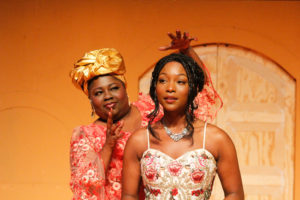

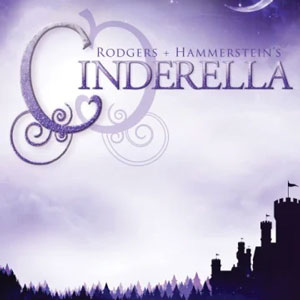
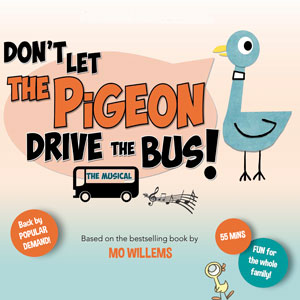


More Stories
“Rodgers and Hammerstein’s Cinderella”
“Don’t Let The Pigeon Drive The Bus”
” The Hip Hop Nutcracker” reviewed by Amy Menzel